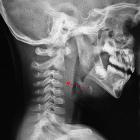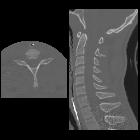cervical spine fracture













Cervical spine fractures can occur secondary to exaggerated flexion or extension, or because of direct trauma or axial loading.
Epidemiology
Males are affected more commonly than females with the median age of injury being 56 years. Falls, motor vehicle collisions, pedestrian accidents, cycling and diving are common causes of injury .
Pathology
The cervical spine is susceptible to injury because it is highly mobile with relatively small vertebral bodies and supports the head which is both heavy and acts as a lever. C2 (~30%) and C7 (~20%) are the most commonly fractured levels .
There are many types of cervical spine fracture, some of which are unstable; general indicators of instability include:
- increased or reduced intervertebral disc space height
- increased interspinous distance
- facet joint widening
- vertebral compression >25%
- more than one vertebral column involvement
Associations
Associated injuries are present in ~67% of patients :
- blunt cerebrovascular injury (BCVI) especially in high cervical fractures, those associated with subluxation and fractures involving the transverse foramen
- rib and/or sternal fractures
- base of skull fractures
- facial fractures
Pediatric
The fulcrum of movement is different in children than adults, C2/3 compared to C5/6, respectively; hence, in children, cervical fractures are more common in upper vertebrae. There are also other anatomical differences of the cervical spine between children and adults which are worth bearing in mind while interpreting pediatric studies. These include more horizontal orientation of the facet joints in children, underdeveloped uncovertebral joints, mild physiological anterior wedging of the vertebral bodies, and incomplete ossification of the odontoid process.
Mechanism
The four major mechanisms are flexion, extension, rotational and shearing, each associated with certain fracture patterns :
- flexion: most common mechanism
- anterior atlantoaxial subluxation
- anterior subluxation (hyperflexion sprain)
- anterior wedge fracture
- clay-shoveler fracture
- flexion teardrop fracture
- bilateral facet dislocation
- hyperflexion fracture-dislocation
- lateral flexion
- unilateral occipital condyle fracture
- lateral mass C1 fracture
- flexion-rotation
- extension
- hangman fracture
- extension teardrop fracture
- posterior arch C1 fracture
- posterior atlantoaxial subluxation
- extension-rotation
- articular pillar fracture
- floating pillar
- axial loading/compression
- burst fracture (with axial loading)
- Jefferson fracture
- complex injuries
Siehe auch:
- verbreiterter prävertebraler Weichteilschatten
- Hyperextensionsfraktur HWS teardrop
- Densfraktur
- Schipperfraktur
- Jefferson-Fraktur
- hangman fracture
- facet dislocation
- Hyperflexionsfraktur HWS teardrop
- unilateral facet dislocation
- Chalk-Stick-Fraktur der HWS
- burst (compression) fracture
und weiter:

 Assoziationen und Differentialdiagnosen zu Frakturen der Halswirbelsäule:
Assoziationen und Differentialdiagnosen zu Frakturen der Halswirbelsäule:






